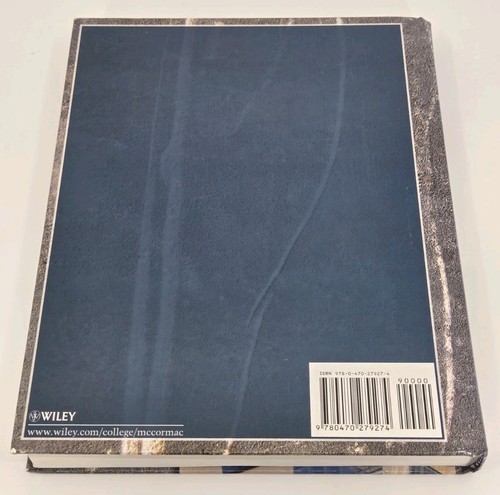Picture 1 of 5

Stock photo





Picture 1 of 5

Stock photo





Design of Reinforced Concrete by Russell H. Brown and Jack C. McCormac (2008, Hardcover)

Fancy Retro Store (349)
100% positive feedback
Price:
US $15.99
ApproximatelyPHP 902.03
+ $63.38 shipping
Returns:
30 days return. Buyer pays for return shipping. If you use an eBay shipping label, it will be deducted from your refund amount.
Condition:
Oops! Looks like we're having trouble connecting to our server.
Refresh your browser window to try again.
About this product
Product Information
With its accessible approach and streamlined coverage of theory, engineers will quickly learn how to apply the concepts in the eighth edition. The contents have been updated to conform to the 2008 building code of the American Concrete Institute (ACI 318-08).Product Identifiers
PublisherWiley & Sons, Incorporated, John
ISBN-100470279273
ISBN-139780470279274
eBay Product ID (ePID)69576528
Product Key Features
Number of Pages720 Pages
LanguageEnglish
Publication NameDesign of Reinforced Concrete
Publication Year2008
SubjectConstruction / Masonry, Materials Science / General
TypeTextbook
Subject AreaTechnology & Engineering
AuthorRussell H. Brown, Jack C. Mccormac
FormatHardcover
Dimensions
Item Height1.2 in
Item Weight0 Oz
Item Length10 in
Item Width8.3 in
Additional Product Features
Edition Number8
Intended AudienceCollege Audience
Dewey Edition23
IllustratedYes
Dewey Decimal624.1/8341
Lc Classification NumberTa444
Table of ContentPrefaceChapter 1. Introduction 11.1 Concrete and Reinforced Concrete 11.2 Advantages of Reinforced Concrete as aStructural Material 11.3 Disadvantages of Reinforced Concreteas a Structural Material 21.4 Historical Background 31.5 Comparison of Reinforced Concrete and StructuralSteel for Buildings and Bridges 51.6 Compatibility of Concrete and Steel 61.7 Design Codes 71.8 SI Units and Shaded Areas 71.9 Types of Portland Cement 81.10 Admixtures 91.11 Properties of Reinforced Concrete 101.12 Aggregates 171.13 High-Strength Concretes 181.14 Fiber-Reinforced Concretes 201.15 Concrete Durability 211.16 Reinforcing Steel 211.17 Grades of Reinforcing Steel 241.18 Bar Sizes and Material Strengths 251.19 Corrosive Environments 261.20 Identifying Marks on Reinforcing Bars 261.21 Introduction to Loads 281.22 Dead Loads 281.23 Live Loads 281.24 Environmental Loads 301.25 Selection of Design Loads 321.26 Calculation Accuracy 331.27 Impact of Computers on ReinforcedConcrete Design 34Chapter 2. Flexural Analysis of Beams 352.1 Introduction 352.2 Cracking Moment 382.3 Elastic Stresses-Concrete Cracked 402.4 Ultimate or Nominal FlexuralMoments 462.5 Example Problem Using SI Units 492.6 Computer Spreadsheets 50Chapter 3. Strength Analysis of Beams According toACI Code 633.1 Design Methods 633.2 Advantages of Strength Design 643.3 Structural Safety 643.4 Derivation of Beam Expressions 653.5 Strains in Flexural Members 683.6 Balanced Sections, Tension-ControlledSections, and Compression-Controlled orBrittle Sections 693.7 Strength Reduction or f Factors 703.8 Minimum Percentage of Steel 723.9 Balanced Steel Percentage 733.10 Example Problems 743.11 Computer Example 77Chapter 4. Design of Rectangular Beams andOne-Way Slabs 794.1 Load Factors 794.2 Design of Rectangular Beams 814.3 Beam Design Examples 864.4 Miscellaneous Beam Considerations 924.5 Determining Steel Area When BeamDimensions Are Predetermined 934.6 Bundled Bars 954.7 One-Way Slabs 964.8 Cantilever Beams and Continuous Beams 994.9 SI Example 1004.10 Computer Example 101Chapter 5. Analysis and Design of T Beams and DoublyReinforced Beams 1095.1 T Beams 1115.2 Analysis of T Beams 1115.3 Another Method for Analyzing T Beams 1155.4 Design of T Beams 1165.5 Design of T Beams for Negative Moments 1225.6 L-Shaped Beams 1245.7 Compression Steel 1245.8 Design of Doubly Reinforced Beams 1295.9 SI Examples 1325.10 Computer Examples 134Chapter 6. Serviceability 1506.1 Introduction 1506.2 Importance of Deflections 1506.3 Control of Deflections 1516.4 Calculation of Deflections 1536.5 Effective Moments of Inertia 1536.6 Long-Term Deflections 1566.7 Simple-Beam Deflections 1586.8 Continuous-Beam Deflections 1606.9 Types of Cracks 1666.10 Control of Flexural Cracks 1676.11 ACI Code Provisions Concerning Cracks 1716.12 Miscellaneous Cracks 1726.13 SI Example 1726.14 Computer Ex
Be the first to write a review





